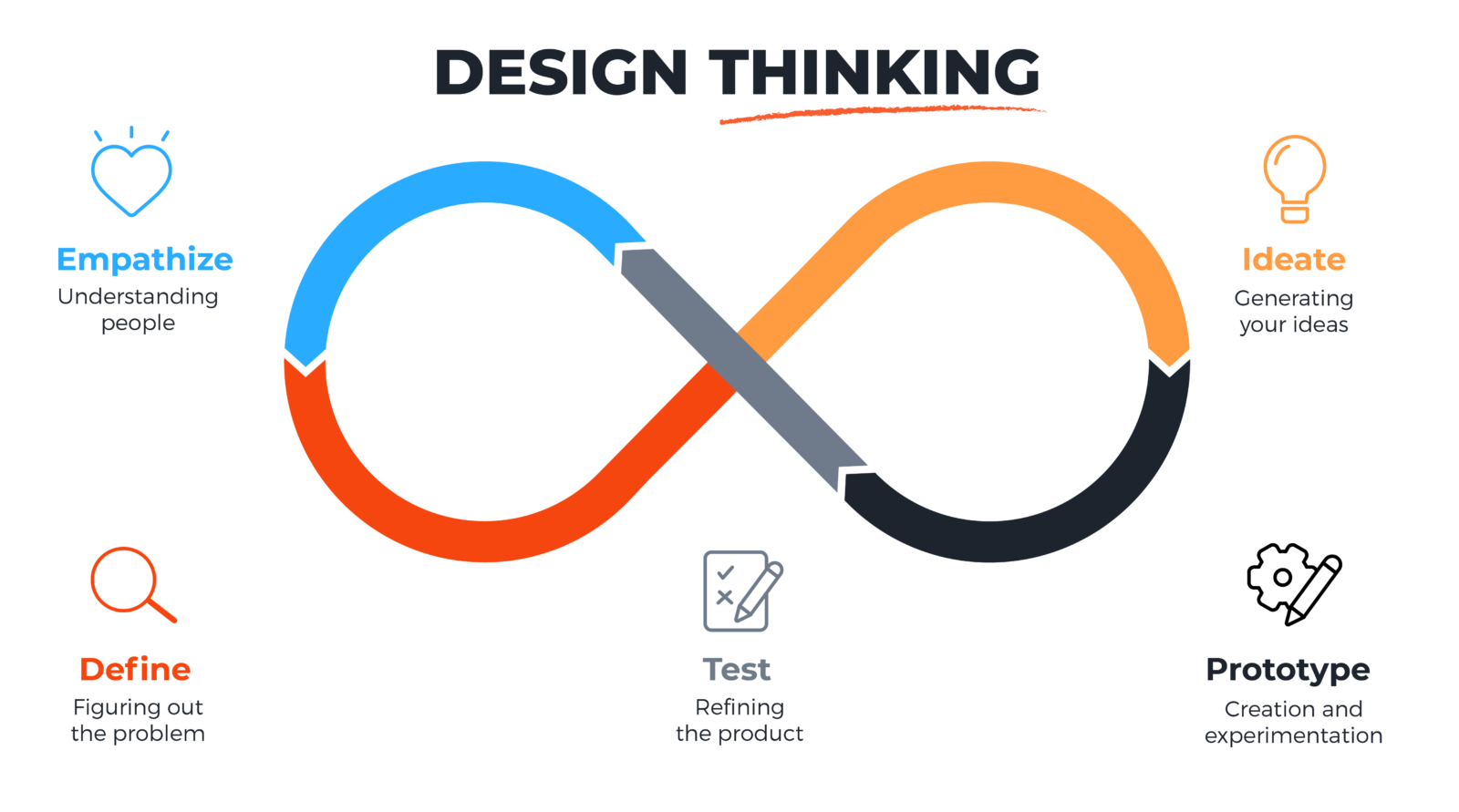Why are businesses so much after customer experiences? The reason is simple – CX has become one of the central selling points nowadays. The market is oversaturated with goods, products, and services; therefore, to attract customers’ attention, you need to offer something unique. You guessed it – customer experience.
This is not just a theory. In fact, customers themselves admit that experience matters. PWC found that for 73% of people, experience has a great influence on their buying decisions, and for 65%, customer experience has more weight than advertising.
OK, but how do you create that perfect one-of-a-kind experience that makes customers love you and come back again and again? The ingredients of the recipe for success include user-centricity, creativity, out-of-the-box thinking, innovation, and courage. When added together, they become design thinking.
What is Design Thinking?
Design thinking is very popular today, but the concept itself is not new – it was first defined in the 1960s. It is a way to solve problems creatively by focusing on the user, identifying their pain points, finding multiple alternative solutions, and testing them.
As the name suggests, design thinking is the way designers approach their problems. However, today this methodology has reached areas that are not about design, such as marketing or business analysis. To find new ways to engage customers and increase their loyalty, marketing professionals began to “think like a designer” and adjust their processes accordingly.
Principles of Design Thinking

Design thinking has five distinct phases that help you reach the perfect solution:
- Empathize, when you focus on your customers and try to understand them better. In this phase, you interview customers and collect their data to get an idea about the problems they would like you to resolve for them.
- Define, when you analyze the data you have collected and identify the problems you need to deal with.
- Ideate, when you brainstorm to generate as many possible solutions as you can, no matter how non-standard or unconventional they may seem. At the end of this phase, you select the most doable ones to proceed with.
- Prototype is when you implement the solutions you found and create working prototypes. You can start with paper prototyping to save time and costs and then move on to develop the most promising ideas.
- Test, when you test the prototypes you have built and decide if they achieve the desired result.
It may happen that testing reveals that your idea is not as viable or effective as you thought, and you need to start over. This is a perfectly normal result, which is not a failure. Instead, you can get valuable information and experience from it.
5 Ways Design Thinking Enhances CX
When you adopt design thinking as your approach to customer-facing activities, you may notice a significant improvement in the customer experience. Let’s see how.
Understanding Customers’ Way of Thinking
That’s what empathy is about. By stepping into the customer’s shoes, you can see what they expect from you. Based on that information, you can change and adjust your products, services, ways of working, and marketing campaigns to meet your customers’ needs.
For example, you may have a live chat on your website as you know that 82% of customers prefer live chat over other contact options, according to the survey. However, you should also remember that all visitors are different and it’s also a good idea to maintain a call center with state-of-the-art phone systems for those people who want to have an option to contact your team fast. The more options you offer, the more customers you can satisfy.
Looking at Problems from a New Perspective
Moving from empathy to problem definition, you might see the problems as the customers see them and even identify those that did not occur to you before. Once you find them, you are halfway to resolving them. As a result, customers will be pleased with your product or marketing campaign, “anticipating” their needs and responding proactively.
You can identify problems by interviewing and surveying your customers. In addition, you can walk the customer’s path and evaluate your experience. This approach is similar to “mystery shopping” in brick-and-mortar stores when the business learns about CX and the related pain points in real-life situations.
Making the Interaction User-Friendly
Empathizing with customers allows for increasing the level of user-friendliness. When you apply design thinking to improve your customer interactions – website browsing, ad viewing, purchasing – you can see ways to simplify and streamline them. As a result, you can achieve much higher user-friendliness that your customers are going to appreciate.
For example, you may find out that customers hate dark patterns and consider them misleading. You can improve their experience by adding transparency to your cookie policies and subscriptions and considering other, more customer-friendly techniques.
Encouraging Customers to Participate
When you ask for customer feedback, invite them to provide improvement suggestions, too. Include such questions as “What do you especially like about our product?” and “What do you think can be improved?”
You will get information based on real experience and learn what people would like to change. Using this information, you can adjust your product to respond to your customers’ needs and expectations. For example, if you get a lot of feedback about your onboarding flow, see which onboarding practices you can use to implement the customers’ improvement suggestions.
Also, check out How to use customer feedback to improve your Site.
Demonstrating Clear Values to Customers
Design thinking allows establishing a dialogue with customers and making them feel a part of the design process. Their involvement starts with collecting their feedback and suggestions. Afterward, it is important to maintain their engagement by touching base regularly and informing them about the improvements you are making.
Adopt a practice of releasing periodic updates on your product where you describe the pain points you are focusing on. This way, you will show the actual value your product or service brings to them. Besides, such communication might improve customer loyalty when they see that the company listens to what matters to them. This way, customer satisfaction grows, which means visitors are more likely to recommend your company to their friends. As a result, it helps to drive more traffic to your website and therefore achieve business growth.
Design thinking is your way to greater customer experiences
Build a trustworthy website to make the experience smooth and lag-free. By focusing on the customer. You can build your whole product around them. With such an approach, customer experience gets a large share of attention and improves significantly. Start thinking like a designer, and you are going to get more happy and loyal customers.




